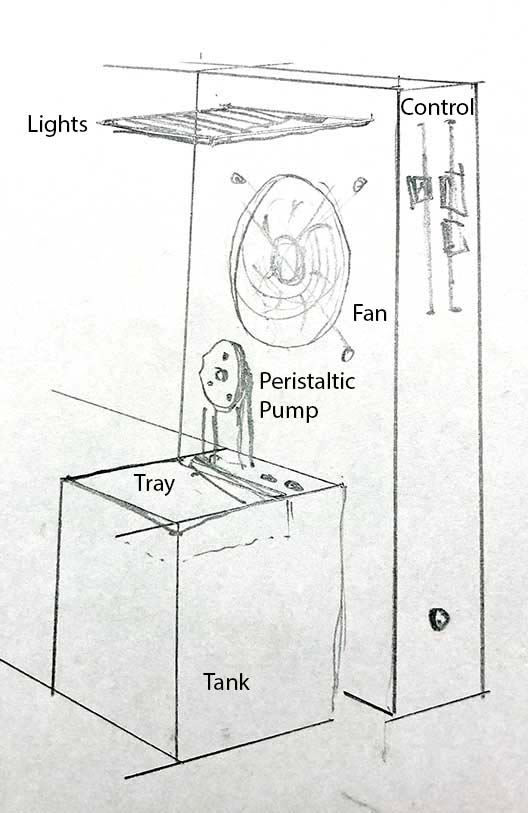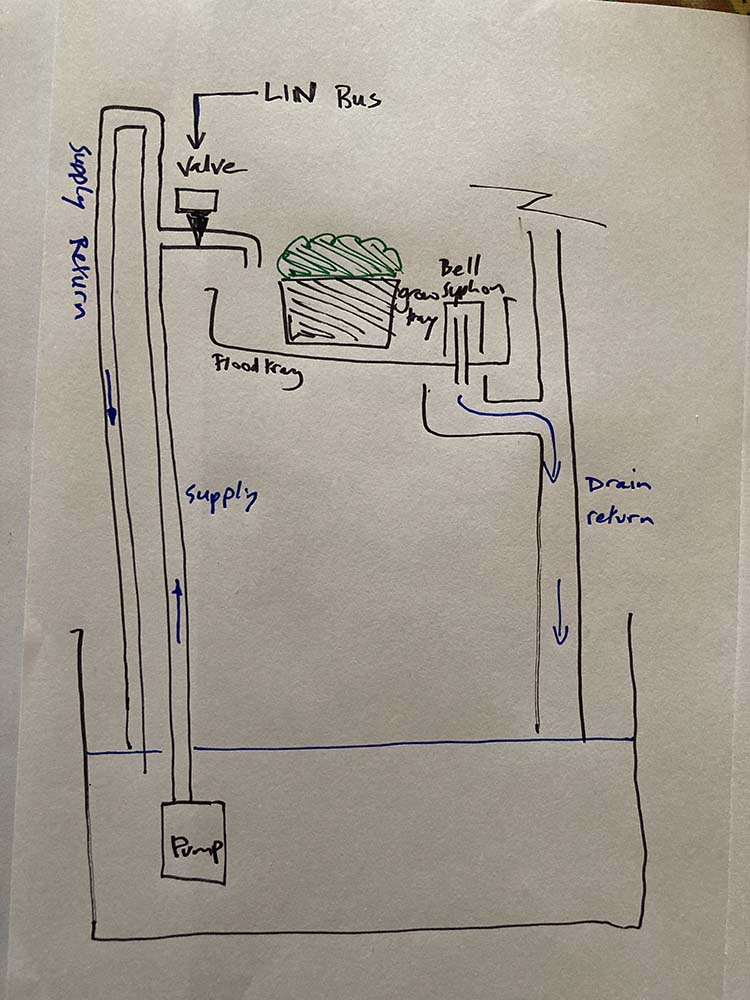Final Project ‘22¶

Problem - Solution (Initial statement)¶
Problem: We need a teaching tool that grows simple leafy greens with little expertise or effort.
Solution: Create a simple to control system that has sufficient complexity to manage a basic growth cycle, managing light, water and air.
Background¶
Over the summer of 2020 I joined a project that challenged it’s participants to build a home hydroponics setup. I opted to mix Kratky pots with some microgreens growing on a readily available rack, I designed and integrated simple lighting from three custom LED panels, managed by a mechanical timer.

The project has been documented on Instagram under the moniker quartermeterfarm.
In ‘21 I described my project:
Yet Another Hydroponics System. For our main project were going to be looking at creating a Kit of Parts, a Lego kit for the physical implementation of basic Agritech. Exploring at different scales, starting within a domestic setting, then looking at small and medium scale growing. Whilst we also look at applications outside the growing of leafy greens.
In ‘22…
This year is a minor refinement, now that I’ve seen a few more Fab Academy projects. For the project I’ll aim to produce a small Microgreens demonstrator growing system. (An integrated product that has a few more functions than your regular commercial tub with LEDs.) I want to use a small system to demonstrate principles in the classroom. It should be sufficiently automated to grow microgreens with minimal intervention. Once germinated I would hope to leave the plants to grow without further attention until ready for harvest. Having had some small experience with the quartermeterfarm and with these aims in mind we have a Minimal Viable Proposition:
- Automated Lighting
- Automated Watering
- Moving Air
The illustration shows a small monolithic slab of material standing behind a tank, suspending a lighting panel. Piercing the slab is a duct for a fan and the visible part of a peristaltic pump. On some surface we will add an analog interface to manage lighting times, water quantities and fan speed.

Component systems:
- 90mm PWM 12v Fan.
- Potentially run at a lower voltage to make it run quieter.
- Eliminate chances of mold growth.
- Gently disturbed plants improve in structure.
- Peristaltic pump
- For microgreens we can dose out water.
- For classroom we could simulate flood and drain system.
- Lighting panel
- Either a panel of bright white LEDs or a combination of Horticulture focussed Red and Blue LEDs
- Horticulture LEDs being more efficient for the specific application than eg. Neopixels. Also at a spectrum ideal for growth.
- Driven by a current source from our 12v supply.
- Variable brightness in two channels.
- On/Off timer for daily lighting period.
- Tank
- We can grow microgreens with just water. No additional nutrients are mandatory in a simple system
- Flood tray / tank lid.
- Water pumped into the flood tray from the tank.
- Feature could include Bell Syphon to do an ebb and flow system. Could be used to fill tank from the tray.
- Peristaltic pump could run in both direction to do similar.
- Will need an overflow back to the tank.
- Plant tray
- Fits into flood tray.
- Lots of holes.
- Contains the grow medium.
Notes on the early prototype, the Quarter Metre Farm¶
- The racking is a small unit of readily available COTS. Larger versions are seen in almost all Microgreens growing enterprises.
- The light are custom made panels.
- 300x300x1.2mm Aluminium sheet acting as mechanical support and heat sink.
- Some kapton tape kept things from shorting
- High CRI White 12V LED strip was applied in 250mm lengths.
- 4 or 6 strips wired in parallel and terminated with bullet connectors.
- bullet connectors were used with opposing genders to ensure that the panels could not be connected to the loom with reverse polarity.
- Many components were purchased from regular hardware/automotive parts stores.
- Lights are controlled with a simple mechanical timer.
- Initial use did not fill the system, so one panel was redundant. Retrofitted some switches in series with the LED panels. Switches were seated in custom laser cut panels that got zip tied to the rack.
- Panels can be isolated from the timer.
- Power in the wiring loom is 12V DC supplier by a MeanWell power supply.
- 230V on the other end. PAT tested.
- Found some half trays, with and without holes to grow Microgreens
- Early crops suffer from Mold
- In the Pea Shoots that was most likely down to soaking the seeds too long
- Found it difficult to propagate for my first Kratky Method, mostly forgot to water the seeds I was trying to start off. Got one going in the end and had a slow growing lettuce.
So, I’ve grown leafy greens in the system and enjoyed the result. But one issue leads us to the problem that this next project should address.
Notes on the Problem Domain¶
Why is the quarter meter farm not growing something now?
At the moment my rack stands empty. During a time of pandemic with some much time spent at home this may be a bit of a surprise, but I think many of us struggle at the moment with small barriers. With this project I aim to explore those little barriers that have stopped me from starting and growing fresh produce. In the micro system I will develop tools that lower the mental effort required to prepare and propagate trays of seed, water and otherwise maintain the plants, organise and sequence the events required to get a regular supply of leafy greens. Tools that could then be applied at different scales, eg in the quarter meter farm.
Looking more broadly if these small systems are designed well they might scale to suit other projects. So whilst we operate in a discovery mode we’ll be talking to a range of potential users and looking more broadly at the Agritech field of Hydroponic systems.
Stretch goals¶
I will complete the simple domestic system first, considering the constraints of a typical Fab Academy project, once the core is complete we could consider adding features.
These features take a monolithic system and splits it up to make a ‘kit of parts’, that would allow for a more flexible approach to building food growing systems.
We would consider adding an IoT enabled infrastructure that would stitch together a cluster of smart nodes. Each node serving a single function, read temp, pump water. We might look to automotive electronics for inspiration. Where clusters of sensors and actuators are connected together by a low cost LIN bus, and connected more broadly by a CAN bus back haul. In our case we consider a wireless back-haul, driving a LIN bus enabled cluster of sensors, lights, valves and pumps.
We can imagine how this fundamental infrastructure could be expanded from the domestic system of a single growing rack, to a variety of applications in a broader Agritech setting.


